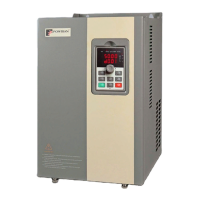Appendix I
73
for(i=0;i<8;i++)
{
if(crc_value&0x0001)
{
c r c _ v a l u e
=
(c r c _ v a l u e
>
>
1 )^0xa001;
}
else
{
crc_value=crc_value>>1;
}
}
}
return(crc_value);
}
I-3 Definition of communication parameter address
The section is about communication contents, it‟s used to control the operation, status and
related parameter settings of the inverter. Read and write function-code parameters (Some
functional code is not changed, only for the manufacturer use or monitoring): the rules of labeling
function code parameters address:
The group number and label number of function code is used to indicate the parameter address:
High byte: F0 to FB (F group), A0 to AF (E group), B0 to BF(B group),C0 to C7(Y group),70
to 7F (d group) low byte: 00 to FF, This address is written to EPPROM
For example: address F3.12 indicates F30C; Note: L0 group parameters: neither read nor
change;d group parameters: only read, not change.
Some parameters can not be changed during operation, but some parameters can not be
changed regardless of the inverter is in what state.When changing the function code parameters,
please pay attention to the scope, units, and relative instructions on the parameter.
Besides, due to EEPROM is frequently stored, it will redUce the life of EEPROM, therefore
under the communication mode some function code do not need to be stored and you just change
the RAM value.
If F group parameters need to achieve the function, as long as change high order F of the
function code address to 0. If E group parameters need to achieve the function, as long as
change high order A of the function code address to 4. The corresponding function code addresses
are indicated below: high byte: 00 to 0F(F group), 40 to 4F (E group), 50 to 5F(B group),60 to

